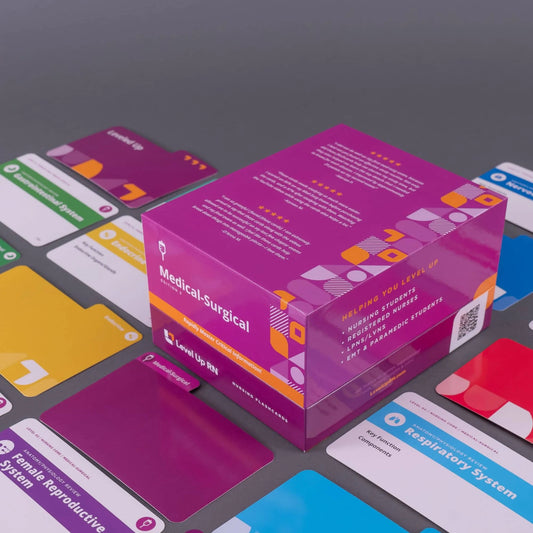Med-Surg - Gastrointestinal System, part 8: Appendicitis and Peritonitis
Updated: Cathy ParkesAppendicitis and peritonitis. The pathophysiology, risk factors, signs/symptoms, diagnosis, treatment and complications associated with these disorders.
Full Transcript: Med-Surg - Gastrointestinal System, part 8: Appendicitis and Peritonitis
Full Transcript: Med-Surg - Gastrointestinal System, part 8: Appendicitis and Peritonitis
Hi. I'm Cathy, with Level Up RN. In this video, I am going to talk about appendicitis and peritonitis. And at the end of the video, I'm going to give you guys a little knowledge check to test your understanding of some of the key points I'll be covering in this video. So definitely, stay tuned for that. And if you have our Level Up RN medical-surgical nursing flashcards, pull those out so you can follow along with me. Anytime you see a condition with -itis on the end of it, -itis means inflammation of whatever is in front. So with appendicitis, that means inflammation of the appendix. With peritonitis, that's inflammation of the peritoneum. So appendicitis is caused when the opening of the appendix becomes obstructed by something like a fecalith, which is a hard, stony mass of feces or a tumor or due to some kind of infection. This causes inflammation of the appendix. It also causes ischemia, so impaired blood flow to the appendix, and that results in bacterial overgrowth.
So in terms of signs and symptoms, the hallmark symptom of appendicitis is right lower quadrant pain at McBurney's point. So if your patient is having pain in that quadrant, then you would definitely be suspicious that appendicitis is present. In addition, the patient will have rebound tenderness in that area, meaning that when you push down, it may not hurt so much. But when you let go, when that skin is rebounding, that's when the patient will have more pain. Other signs and symptoms include loss of appetite, nausea and vomiting, as well as fever. We would diagnose the patient with appendicitis using a CT scan. In addition, their labs may show elevated white blood cells.
In terms of treatment for a patient with appendicitis, they will be placed on NPO. We will provide IV fluids and antibiotics. And then in terms of surgery, we're going to do an appendectomy, which is removal of the appendix. Typically, we can do this through a laparoscopic approach. But if the appendix has ruptured, then they may require an open appendectomy, where we open up the whole abdomen. In terms of complications, peritonitis and perforation are two possible complications if the appendix ruptures. So if your patient is having pain with their appendicitis and they suddenly say, "Wow, all that pain just went away," then that is actually a red flag and may mean that their appendix has ruptured.
Next, let's talk about peritonitis, which is inflammation of the peritoneum, which is that serous membrane that surrounds the abdominal organs. So with peritonitis, we have contamination of the peritoneal cavity with bacteria, and this leads to inflammation. Things that can cause the peritoneal cavity to become contaminated include trauma, infection, as well as perforation of an organ, such as perforation of the appendix, of diverticulitis, or of peptic ulcers. So signs and symptoms of peritonitis include a rigid board-like abdomen. That is a key symptom of this condition. Other signs and symptoms include abdominal pain, nausea and vomiting, fever, rebound tenderness, as well as tachycardia.
Diagnosis of peritonitis can be done using an abdominal x-ray, CT, or ultrasound. In terms of treatment, a patient with peritonitis will be placed on NPO, and we will place an NG tube to decompress the stomach and then provide IV fluids, antibiotics, and analgesics. If the cause of the peritonitis was due to a ruptured organ, then the patient will need to undergo surgery to repair or remove that organ. And then they will also need an intra-abdominal lavage, which means we're going to be opening them all the way up and washing out that whole peritoneal cavity due to that contamination. And then we need to closely monitor our patient for signs and symptoms of sepsis because this is definitely a key complication that can happen with peritonitis.
All right. It's quiz time. Question number one. Where is McBurney's point? The answer is the right lower quadrant of the abdomen. Question number two. If your patient with appendicitis reports sudden relief of pain, what might you suspect? The answer is rupture of the appendix. Question number three. A rigid, board-like abdomen, nausea and vomiting and fever are signs of what disorder? The answer is peritonitis. Okay. I hope you found that quiz helpful, as well as the video. If so, be sure to leave me a comment and like this video. Take care, and I'll see you soon-- of the appendix or-- diagnose peritonitis using [inaudible] the appendix of [inaudible].



1 comment
Your document is good brief